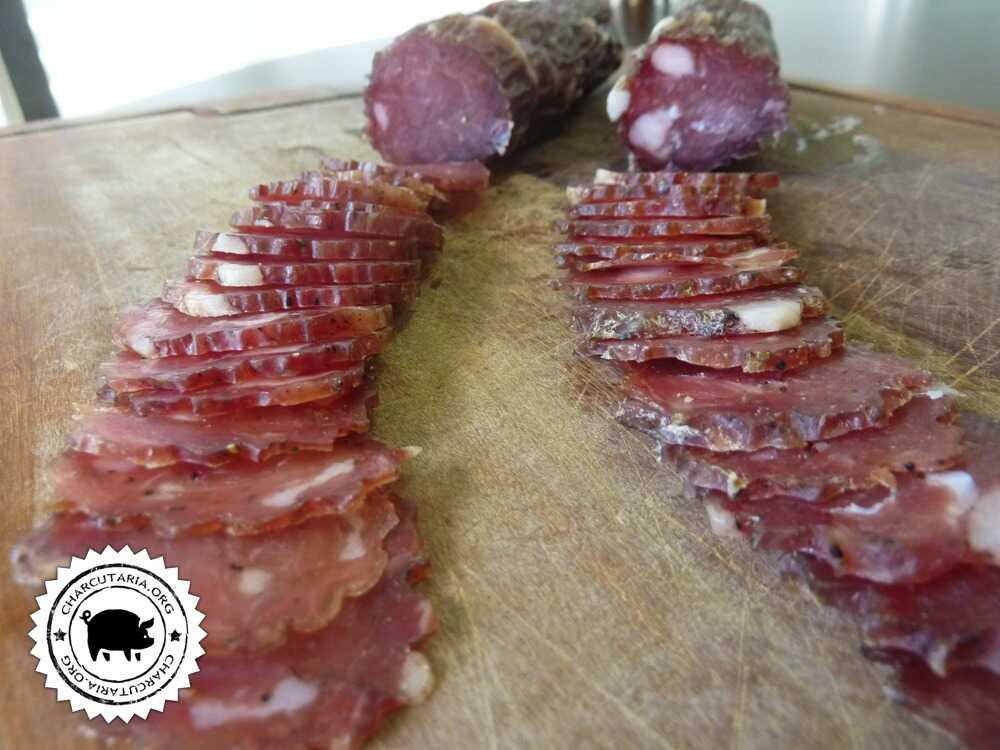
This salami was made to test an alternative solution to traditional curing in an air-conditioned environment, with controlled temperature, humidity and air flow. It is also an alternative to using baking paper, which is a terrible wrapper as it was not designed for this purpose, cannot properly control moisture loss and does not adhere to the product, leaving a layer between the paper and the salami that is conducive to the emergence of unwanted molds. The refrigerator is very dry, so it is important to adapt an environment in which humidity is preserved. Ventilation is also essential for moisture exchange dynamics to occur.
The first attempt was made with a cardboard box, which did not work, the humidity was not preserved, I believe due to the cardboard's porosity and ability to draw water. The second solution tested, which worked, was a plastic box with a computer fan connected to a rechargeable battery and a 3.5V charger. This adaptation created an environment that maintained high humidity (close to 80%) and the light ventilation necessary for the correct maturation of the salami. The low refrigerator temperature delays maturation a little, but does not degrade the quality of the salami.
The box needs to be the height compatible with the salami, in this case the box is 33cm high and the salami casing is 30cm long, with the shortening by tying the ends the size was perfect. Adapt according to your needs.
You can control humidity by opening or closing a gap in the box lid. At first the salami is very moist and the humidity increases quickly. Open the lid slightly until the humidity stabilizes around 80%. If the humidity gets low, just close the lid. Checking once or twice a day is enough.
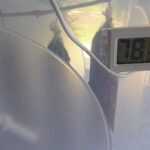
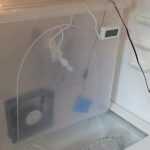
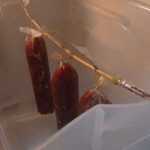
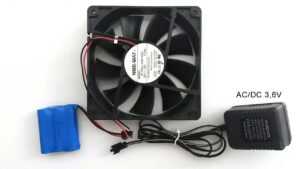
Ingredients for homemade salami made in the fridge
- Ham – 1000g;
- Salt – 20g – 2%;
- Black pepper – 2g – 0.2%;
- Ginger powder – 1g – 0.1%;
- Nutmeg powder – 1g – 0.1%;
- Dehydrated garlic – 4g – 0.4%;
- Fennel – 2g – 0.2%;
- Curing salt 2 (6% of nitrite, 3% of nitrate and 93.75% of salt) – 2.5g – 0.25%;
- Antioxidant (with sodium erythorbate) – 2.5g – 0.25%;
- Red wine – 20g – 2%.
Preparation of artisanal salami made in the refrigerator
Cut the meat and fat finely with a knife or grind into a fine disc;
Mix all the ingredients well until the salami dough becomes sticky. Approximately 2 minutes. You can mix with your hands, using an orbital mixer or kneader.
Embed in straight collagen or natural beef casing measuring between 45mm and 60mm, depending on the desired thickness of the salami. In this case I used 45mm collagen casing.
If using collagen casing, hydrate it for a few minutes in water with 10% salt.
Poke holes with a pin/needle or pricker to remove air bubbles that are trapped between the casing and the salami dough. Air bubbles oxidize the fat and create areas with a different color and rancid taste, which is why they need to be removed.
Weigh each salami and record the initial weight.
The use of starter culture is optional. If you use wine, the fermentation phase is optional as the wine acts as an acidifier. Fermentation in salami generates lactic acid and protects it through acidification. The starter culture adds flavor and aroma through enzymatic action that is fundamental in the formation and color stability of the final product. The starter culture also has lipolytic and proteolytic activities, involved in aroma formation. Use if you want to add more quality to the product.
The refrigerator is very dry, so it is important to adapt an environment in which humidity is preserved. Ventilation is also essential for moisture exchange dynamics to occur. The plastic box fitted with a fan creates an environment that can maintain high humidity and the ventilation necessary for the salami to ripen correctly. The refrigerator temperature is generally around 4ºC to 7ºC, it is not the ideal temperature but the most critical thing is humidity and ventilation, so it is fully possible to make a great salami in the refrigerator.
Leave it hanging inside the box in the refrigerator until the salami has lost between 35% and 40% of its initial weight.
Salamis weight loss
SALAME 1
starting weight: 353g
final weight: 186g
loss: 47%
SALAME 2
starting weight: 363g
final weight: 188g
loss: 48%
SALAME 3
starting weight: 277g
final weight: 141g
loss: 49%
Final result of salami
The salamis were great, excellent flavor and consistency. The conclusion is that it is entirely possible to make great salami in the refrigerator, just adapt an environment with light ventilation and maintain high humidity.
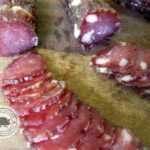


-
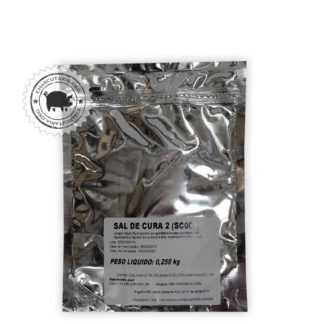 Curing salt 2R$ 8,00
Curing salt 2R$ 8,00 -
 Curing salt 1R$ 8,00
Curing salt 1R$ 8,00 -
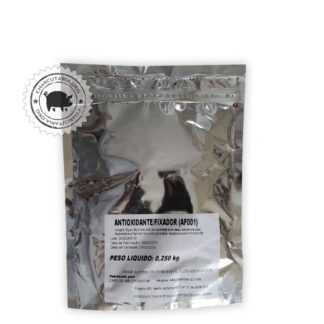 Fixative AntioxidantR$ 23,00
Fixative AntioxidantR$ 23,00 -
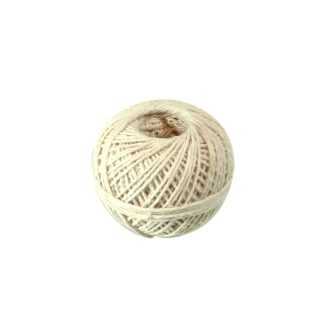 Culinary twineR$ 7,90
Culinary twineR$ 7,90 -
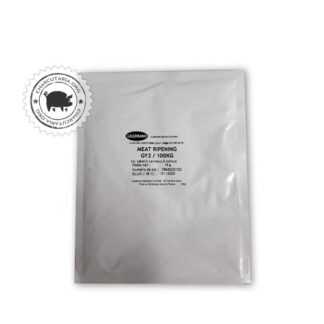 Starter CultureR$ 69,90
Starter CultureR$ 69,90 -
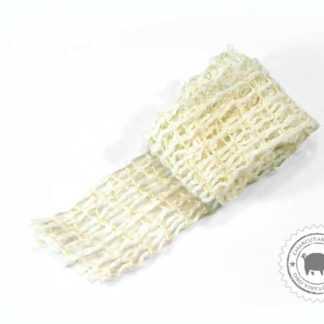 Culinary elastic net 50mmR$ 15,00
Culinary elastic net 50mmR$ 15,00 -
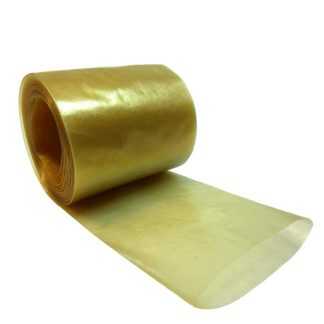 Collagen casing 45mm roll 5 meters salamiR$ 19,00
Collagen casing 45mm roll 5 meters salamiR$ 19,00 -
 Culinary elastic net 65mmR$ 18,00
Culinary elastic net 65mmR$ 18,00 -
 Collagen casing 80mm cup and salamiOriginal price was: R$ 39,00.R$ 29,90Current price is: R$ 29,90.
Collagen casing 80mm cup and salamiOriginal price was: R$ 39,00.R$ 29,90Current price is: R$ 29,90. -
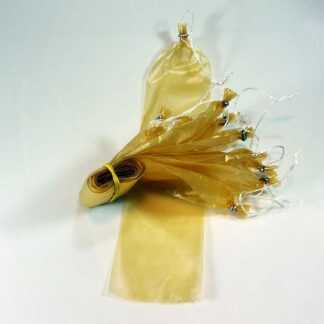 Salami collagen casing 45mm 10 units tiedR$ 19,00
Salami collagen casing 45mm 10 units tiedR$ 19,00 -
 Galvanized HookR$ 12,00
Galvanized HookR$ 12,00 -
 Natural pork casing for sausageR$ 52,00
Natural pork casing for sausageR$ 52,00

Good afternoon…
Which elastic mesh should I use in the 60 gauge collagen casing?
Altair
The smallest one, the 50 mm elastic net, will do the trick. These presented measurements of the nets are the contracted measurements, that is, they stretch twice that size to be able to place the product inside. The network always has to be a little smaller than the product for compression to occur.
Hello everything is fine?
Do you need to smoke in the fridge or can you do the smoking beforehand?
You can smoke it beforehand, it is even highly recommended as it helps with protection. With the lowest possible temperature when smoking, so as not to cook the meat.
Cool, thanks for the information.
Hello, what is the ideal temperature to ripen in the refrigerator?
Hi, Caetano. Ideally, the temperature should vary between 12ºC and 14ºC. But salami will still mature at lower temperatures, such as 4ºC or 6ºC. The important thing is to keep the humidity high, close to 80%.
I made the salami as per instructions but something went wrong, it was extremely tasty but the texture seemed dry.
Hi Alessandra. There may be some factors that make the salami dry, with a brittle texture. The meat may have been frozen and defrosted incorrectly, damaging the protein structure, another problem may have been excessive acidification, in this case the use of wine may be slightly reduced to correct it. You can also make use of a starter culture to better control acidification.
Good morning Eduardo, I followed the recipe for this salami, and I have a problem with curing time!
I did it on 3/22 and today I went to do a sample weigh-in and to my surprise all 6 were already at the ideal weight of 40% reduction! I made some holes to let the air bubbles out. I always use a tightly sealed plastic box! I placed it in a ventilated area inside the house and used a room humidifier with a lot of steam pumping it into the box, as the weather here in BH is very hot and dry! What happened? Can it be consumed now? Thank you in advance for your feedback,
Hugs, Gilberto
Hi Gilberto. The only explanation I see for such an accelerated loss is the combination of dry weather and direct wind over the salamis. If the casing is of low caliber, the loss is also more accelerated. I recommend that you turn off the wind or close the air passage in the room, leave it until it loses about 45%, then pack it in PVC or vacuum and leave it in the fridge for a week to stabilize the internal humidity. Then you can eat, accelerated weight loss actually helps protect the salami more quickly due to the unavailability of water for the proliferation of contamination. Hugs.
Which manufacturer of this plastic box? How many liters?
Plasvale 25L Ref. 294
Good morning. Regarding the time that the salami rests for 24 to 48 hours before embedding, I ask if it could not be embedding FIRST and THEN leaving it to rest?
What are the consequences of this reversal in order?
Hi Jesus Papini. You can grind, mix well and immediately after embedding, there are no restrictions and there will be no difference in the final product.
I placed a fan inside the refrigerator right at the bottom next to a vase of water. Does it help?
Yes, it should help, but the only way to know precisely is to measure the humidity near the salami with a hygrometer.
Good afternoon, I made my salami and I'm leaving it at ventilated room temperature for that period, I wanted to know if I necessarily need to take them to the refrigerator for curing, and do they still need to be rolled in baking paper, a friend of mine said that I can cure them in the room, if For the fridge, you don't need parchment paper. Thank you and I'll be waiting
There are several salami recipes, depending on the technique, thickness, application of smoke or fermentation, the salami will or will not require refrigerated environments. We have recipes for some salami that were made in the fridge without baking paper or outside the fridge, see below:
https://charcutaria.org/receitas/receita-de-salame-colonial/
https://charcutaria.org/carnes/salaminho-misto-aperitivo-em-3-dias-receita-salame/
Goodnight. Congratulations on the site and thank you for sharing your knowledge. I have a question: Mine have already lost 47% of weight in 16 days, from what I saw in several comments from people, this is due to the low humidity, right. From what I saw in your answers, you would have to control the humidity by making it higher, right? But in my case, I'm making them straight in the fridge and they're wrapped in baking paper and made with fermented milk. My question is if with this curing time (16 days) I can safely consume it or if there is a minimum time to consume it? Does the flavor also get better when cured for longer or is it more of a texture issue? Thank you, big hug!
Hi Wagner. Losing the desired weight is now possible to consume, there is no minimum time. Rapid loss in the refrigerator as common is actually due to low humidity. Your salami may have a very dry, harder exterior and a softer, moister interior. In low humidity, the exterior dries quickly and prevents moisture from migrating into the environment. But that doesn't stop consumption. A big hug!
Good evening, Eduardo. Thanks for the answer. It really looked drier on the outside and soft on the inside. But the flavor was ok. Next time we'll see how it turns out. It cost! Araço.
I have a refrigerator with a controller and I can set the temperature I want.
Therefore, ventilation would also be necessary, or as it remains at a stable temperature there is no need, and it will not be opened until the end.
Hi Alcindo, even in a refrigerated environment you need very light and constant ventilation. Air movement is what enables the exchange of humidity between the product and the environment.
Hello,
All is well?
Can I make a Copa Sirloin in this box too?
I see a lot of examples of using baking paper. But I liked your idea. But can I get a Copa Lombo in this box?
Hi Júnior Sena, you can win the World Cup this way, it will work.
Good afternoon. Can I use a 12v source instead of the 3.6v source?
Hi Luiz, yes you can. Point the wind towards the sides of the chamber so that strong wind does not fall on the products.
Hey goodnight. Firstly I would like to congratulate your website. It is an incredible help for those of us who are just starting out in this incredible hobby of charcuterie. Congratulations indeed. Well, my question is the following: how do I calculate the weight of the salami, do I do it based on the initial weight it is when bagged, or do I count it after 3 days of fermentation in the chamber? I say this because I saw that during this fermentation period he loses weight too! When I weighed the salamis, I started the calculations with the post-fermentation weight, that is, not using the initial weight. They're looking good, but I'm worried about them drying out too much.
Thank you and once again, congratulations on the channel
Hi Adriano, the weight must be calculated with the salami immediately after being bagged, before fermentation as all the water lost must be accounted for. But it won't make much difference to have weighed it after fermentation, when the salamis lose around 38% of their weight I believe they are ready.
After curing the salami in the refrigerator. What is the best way to store it? Should I keep it in the refrigerator or can I store it in a ventilated cabinet, for example.
After the process is complete, the ideal is to clean it well, remove the casing, vacuum pack it or wrap it in several turns of PVC plastic and store it in the refrigerator. It will last around 90 days. If left hanging, it will continue to dry and consequently harden too much.
Hello. I want to know how they did it when there was no electricity or a refrigerator… Do you have any ancestral recipes?
Salami was a seasonal product, produced in autumn in countries where winter is harsher. The technique was developed as a form of survival, to preserve meat during periods of greatest food scarcity. In the autumn of these countries, the environment was mild and humid, ideal for the production of salami (and other products) without the need to maintain an artificially controlled environment. The recipe hasn't changed much, the salt concentration used to be higher, with around 3% over the weight of the dough to guarantee more protection.
Hello, how can I store the salami made in the refrigerator, only in the refrigerator it became very hard
You need to wrap the PVC plastic in a few turns so that the salami stops losing water, this way it doesn't harden.
Odors
Good afternoon, I took a recipe online, used curing salt and left the salami in a plastic box at room temperature for 4 days. I wrapped them in butter Pepel and left them in the fridge, but after 20 days it started to have a strong, not very pleasant odor. Is it part of the process or can I consider it lost?
Hi Hudson. Do you know how much weight the salamis lost in those 20 days? Baking paper can cause this problem because depending on the brand it does not have porosity and the salami does not “breathe”, does not lose moisture to the environment and ends up spoiling as water loss is a key point in protection. Wash the salami well and return it to the refrigerator without the baking paper. Leave it for a few days and monitor the scent.
Good morning, I have a question about salami filling. I have an electric meat grinder, the botinni B09, it grinds and can also be embedded. My question is regarding embedding using the grinder: Can it lose the consistency of the dough by crushing it? If this happens, is it advisable to buy a cannon to do the inlay?
Hi Francisco. The grinder actually tends to force the meat more than the cannon, but for salami this is not a problem. For fresh sausages, crushing the meat excessively can cause problems with the final texture of the product.
Thanks for the tip
What is the reason for wrapping the pieces in the band?
They were only embedded in the collagen casing.
Hi, so can I store it in lard like my grandfather did 80 years ago without a refrigerator and without power?
I believe you can do this, it's a very old technique that works. There is canned meat or “confit” that uses this procedure.
Good afternoon!
Would it be problematic to “hang” the salamis horizontally or rest them on a rack? To allow the use of a box not as tall as the one you suggest. Thanks!!
No problem, just turn them frequently.
Good morning!!
I have another doubt...
When you say 20g of wine, do you mean 20ml or did you actually weigh the wine?
These 20g give an average of how many ml??
Thank you very much!!
Hi Sidney, yes it is 20g, I do it based on the weight. 20g gives practically 20ml, minimal difference in density. You can measure in ml if you don't want to weigh it.
Perfect thank you!!!
Good afternoon,
I would like to share something, didn't you actually pierce the salami to remove possible air bubbles?
Thank you very much and congratulations!!
Hi Sidney, it is only necessary to drill when there are apparent air bubbles, otherwise the casing already has the correct porosity so there is no need to drill.
Thank you very much!!!
Good morning, I made the recipe and the salami is reaching 40% of the weight lost. I put it in a temperature-controlled fridge but I had to turn it down to 2º (because it's the same one where I make beer), will it possibly stop losing weight?
Another thing (this is even more important), how does the completion of the process indicate for those who don't have a vacuum sealer? I read you talking about putting it on with several turns of cling film, but can I do this without the collagen casing? (I believe that if you remove it, the fungi that are outside will all come out, easier than cleaning). I read in some post about applying olive oil too, do I do this before wrapping it in cling film or just when eating?
Hi Felipe. Yes, you can reduce it to 2ºC, it will slow down maturation (flavor and aroma development) but you will continue to lose weight. At the end you can remove the casing, wash it well and apply olive oil, then wrap it several times in PVC film and store it in the fridge, it will last around 60-90 days, depending on how much weight you have lost. With 45% of weight loss it's already great, more than that and it becomes very rigid.
Thanks, thank you very much! Do I wash the salami with running water from the sink?
Yes, treated tap water. Just avoid water from a well or other untreated source.
Good morning. We made our salamis on Friday, they are set to cure at 23/24 degrees, but they are showing white mold, is that normal? What do I do? I already made it again and it only showed this after curing in the fridge.
Hi Luiz. Mold/mildew is one of the most common problems. You're letting it ferment for 3 days, is that it? Does it then go to the fridge? In any case, if you have not applied a mold type culture (penicillium), then the ideal is to clean the salami well by rubbing water with salt and vinegar to remove any mold that appears during the entire process. If you have applied the mold type culture, then you can allow the very white mold that appears on the outside of the salami to proliferate.
Good morning!
I made the salami in the fridge and I'm trying to control the temperature and unit as much as possible according to recommendations. In 5 days he has already lost around 25, 27 %. Is correct? What is the average loss per day?
Hi Douglas. At the beginning, salami has a lot of moisture and loses weight quickly, as it dries this loss rate will reduce drastically. So, at the beginning, a very accelerated loss is normal. In any case, if you want to reduce this rate a little to increase the maturation time, increase the humidity inside the box a little or reduce/remove the ventilation for a few days.
Hello, how much weight can a salami lose?
More than 45% it can start to become too rigid.
I bought a used Frost Free refrigerator just to make salami, I'm going to buy the temperature and humidity controller now. I would like to know what is the ideal temperature and humidity for the loss of 30 %. I'm going to use collagen casing measuring 45 mm by 40 cm with 500 grams of loin and as a difference I want to do it with as little fat as possible and I'm going to use yakult
Will the salami be hanging and at a distance of 5 cm from each other do I need to install fans to circulate the air?
Thank you very much
Hi Daniel, keep the temperature at 12ºC throughout the period. Humidity can remain at 90% for the first 5 days and then reduce to 80% and remain there until the end. Light and constant ventilation, not incident on the products, is necessary so that there is an exchange of humidity between the products and the environment. Without air circulation, the products take a long time to dry and can spoil due to excess humidity.
Hi Eduardo, I used Yakult in the fermentation recipe but I forgot to add sugar, should I discard the salami? Hug
Hi Fabiano, there is no need to discard it, follow the process in the cold environment and it will probably work. The lack of sugar will hinder the action of lactic acid bacteria, but this is not a deterrent. There are many salami recipes without using cultures.
But does this recipe include sugar? I thought the antioxidant would replace
Sugar has a distinct function as an antioxidant. A source of sugar is indicated when the starter culture is used, as it is the food for the bacteria that will carry out the fermentation.
One question: I built a chamber in a refrigerator with all the controllers. My question is whether I leave the fans on 24 hours a day or whether they should turn on and off along with the humidifier.
Hi Luiz, you should leave the fan on 24 hours a day. The wind should be light and not affect the products, point towards the side of the refrigerator so that the air circulates smoothly throughout the room.